Does HazCom standard apply to railroad industry?
Letter clarifies OSHA-DOT jurisdiction

December 23, 2014
Mr. Charlie Jones
SMART- Transportation Division
Texas Legislative Executive Board Vice-Chairman
Local 1886 Legislative Representative/Alternate Delegate
10300 Cypresswood Drive #1713
Houston, Texas 77070
Dear Mr. Jones:
This letter is to follow up on the interim letter sent to you dated June 24, 2014, by the Occupational Safety and Health Administration (OSHA). In your original April 1, 2014, letter you requested clarification on whether railroad train crews performing work as hazmat employees are subject to the OSHA Hazard Communication Standard, 29 C.F.R. § 1910.1200. Please be aware that this response is not applicable to any question or situation not delineated within your original correspondence. We apologize for the delay in our response.
Background
The Occupational Safety and Health Act of 1970 (OSH Act), 29 U.S.C. § 651 et. seq., provides OSHA with the authority to issue and enforce standards and regulations for workplace safety and health. Pursuant to this authority, OSHA established its occupational safety and health standards which are designed for the purpose of protecting workers in the workplace.
Section 4(b)(1) of the OSH Act (29 U.S.C/ §653(b)(1)), states that:
Nothing in this Act shall apply to working conditions of employees with respect to which other Federal agencies [. . .] exercise statutory authority to prescribe or enforce standards or regulations affecting occupational safety or health.
Your question is paraphrased below, followed by our response.
Question: Do the requirements of the Hazard Communication Standard (HCS), 29 C.F.R. § 1910.1200 apply to railroad train crew members when they are engaged in hazmat operations?
Response: The Hazardous Materials Transportation Uniform Safety Act of 1990 (HMTUSA) authorizes the U.S. Department of Transportation (DOT) to regulate the transportation of hazardous materials (hazmat) by various modes of transportation, including rail. However, the following subsections of section 5107 of the HMTUSA (49 U.S.C. § 5107) state:
(d) Coordination of Training Requirements.—In consultation with…the Secretary of Labor, the [DOT] Secretary shall ensure that the training requirements prescribed under this section do not conflict with or duplicate—
(1)the requirements of regulations the Secretary of Labor prescribes related to hazard communication, and hazardous waste operations, and emergency response that are contained in part 1910 of title 29, Code of Federal Regulations; and
(g)(2) An action of the [DOT] Secretary under subsections (a)–(d) of this section and section 5106 is not an exercise, under section 4(b)(1) of the Occupational Safety and Health Act of 1970 (29 U.S.C. 653(b)(1)), of statutory authority to prescribe or enforce standards or regulations affecting occupational safety or health.
Therefore, the DOT rules on hazmat transportation do not preempt OSHA from enforcing occupational safety and health standards regarding hazmat transportation. Yellow Freight Systems, Inc., 17 BNA OSHC 1699, 1700-1701 (Docket No. 93-3292, 1996). It should be noted that OSHA’s HCS provides at 29 C.F.R. § 1200(f)(5):
(5) Chemical manufacturers, importers, or distributors shall ensure that each container of hazardous chemicals leaving the workplace is labeled, tagged, or marked in accordance with this section in a manner which does not conflict with the requirements of the Hazardous Materials Transportation Act (49 U.S.C. [5101]… et seq.) and regulations issued under that Act by the Department of Transportation.
You may wish to contact the Federal Railroad Administration Office of Railroad Safety, Hazardous Materials Division, for guidance on its hazmat regulations. You can reach this agency at:
Federal Railroad Administration
RRS-12 Mail Stop 25
1200 New Jersey Ave., S.E., Washington, D.C. 20590
Phone: 202-493-6245
Fax: 202-493-6478
hmassist@dot.gov
Thank you for your interest in occupational safety and health. We hope you find this information helpful. OSHA requirements are set by statute, standards, and regulations. Our interpretation letters explain these requirements and how they apply to particular circumstances, but they cannot create additional employer obligations. This letter constitutes OSHA's interpretation of the requirements discussed. Note that our enforcement guidance may be affected by changes to OSHA rules. Also, from time to time we update our guidance in response to new information. To keep apprised of such developments, you can consult OSHA's website at http://www.osha.gov.
If you have any further questions, please feel free to contact the Office of Health Enforcement at (202) 693-2190.
Sincerely,
Thomas Galassi, Director
Directorate of Enforcement Programs
Looking for a reprint of this article?
From high-res PDFs to custom plaques, order your copy today!




